Both a humidifier and dehumidifier can help eliminate respiratory ailments like chest congestion and asthma, by improving the indoor humidity levels.
Let’s take a look below and figure out which one will better suit your needs.
 What is a Humidifier
What is a Humidifier
A humidifier is a device that increases the humidity (moisture) in the air to combat a dry environment. Increasing the humidity in a dry room has many health benefits such as helping to prevent skin irritation due to dryness, and to help to ease common symptoms of a cold or flu.
There are different styles of humidifiers to choose from; for example, a point-of-use humidifier is one of the most common because they are portable and are often used to target a single room. A central humidifier or whole-house humidifier can be attached to a furnace and take advantage of the homes HVAC system to provide humidity throughout the entire home.
A Humidifier Can Help With
-
- Sinus congestion
- Headaches
- Dry/scratchy throat
- Dry cough
- Chapped lips
- Bloody noses
- nose irritation
Benefits Of a Humidifier
- Improves moisture in the skin -humans need to keep a certain level of moisture in the skin; otherwise, problems will start to manifest. For example, if your skin is flaky, fragile, and itchy, then it is likely that there is not enough moisture in the air, and it’s causing your skin to dry out.
- Reduces the chances of snoring – that’s right, if the air is too dry, likely, the areas on the back of the tongue, nasal cavity, and throat are becoming dry. When this happens, a person will typically snore. Adding more humidity in the air can help reduce snoring.
- Reduces the chances of allergies – if the nasal cavity, mouth, and throat are becoming dry, then there’s a higher chance that an allergen will trigger an allergic reaction.
Different Types of Humidifiers
There are different types of humidifiers to choose from, but each adds moisture to the air. Choosing the right humidifier comes down to a matter of personal preference.
Cool Mist Humidifiers
Cool mist humidifiers disperse a cool room temperature mist/spray into the air. Cool mist humidifiers are generally preferred by most parents because there is no heating element or warm mist to worry about. And since the water is not heated, they tend to use less electricity.
There are two types of cool mist humidifiers: Evaporative and Ultrasonic. Both of these types produce the same result; however they both work in different ways. I’ll go over those more below.
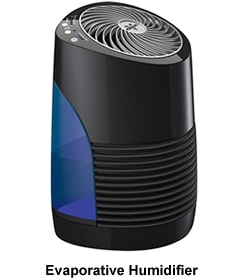 Evaporative Humidifiers
Evaporative Humidifiers
Evaporative humidifiers are one of the most traditional types of humidifiers. A fan works to pull in warm air from a room and then passes that air across an internal water-saturated wick filter, which absorbs the moisture. The fan then blows the saturated air back out of the unit and into your space, filling it with ultra-fine, invisible mist.
Recommended model: Vornado Evap2 Evaporative Humidifier – on Amazon for $79.99 Click here for current price.
PROS:
-
- Works great at covering larger areas.
- It does not generate heat, making it much safer around children and pets.
- Great for helping to treat asthma and allergies.
- Easy to clean, with little maintenance.
CONS:
-
- The fan causes some noise.
- The fan can often make the dispersed air feel a little cooler than it should be.
- The filter/wick collects minerals left behind by water, especially hard water, and needs to be replaced frequently, which adds extra operational costs to this type of unit.
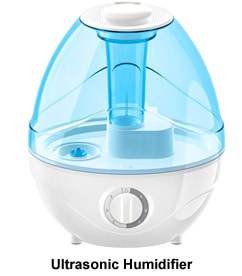 Ultrasonic Humidifiers
Ultrasonic Humidifiers
The ultrasonic humidifier uses vibration technology to break down water into tiny microscopic droplets that are sent out of the unit and into the air. The vibration is so quick that it emits a high frequency, which is above the range for humans to hear. Hence the name, ultrasonic.
Since the ultrasonic humidifier does not rely on a fan to distribute moisturized air into the room, they tend to run a lot quieter than the evaporative humidifier.
Recommended model: LEVOIT 2.4L Ultrasonic Cool Mist Humidifier – on Amazon for $39.99 Click here for current price.
PROS:
-
- Works great at covering larger areas.
- Much quieter unit.
- Great for helping to treat asthma and allergies.
- It does not generate heat, making it much safer around children and pets.
- It uses less electricity, which in the long run saves you money.
- You never have to replace a filter or wick on the ultrasonic humidifier.
CONS:
-
- The ultrasonic humidifier collects minerals that it then turns into what is called “white dust,” which can get on things like furniture. However, you can avoid “white dust” by using distilled water in the humidifier.
- Although much quieter than the evaporative humidifier, you can still hear a very slight hum, especially in a quiet bedroom.
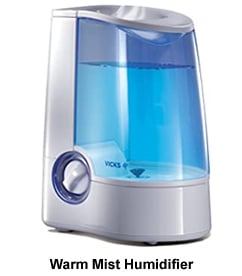 Warm Mist Humidifiers
Warm Mist Humidifiers
The warm mist humidifier uses a built-in heating element that first boils the water before releasing it into your space. Because the water gets boiled first, it can help kill off bacteria or mold that may be growing in parts of the humidifier. This type of humidifier is said to be one of the healthiest types that you can buy.
Recommended model: Vicks Warm Mist Humidifier – on Amazon for $38.55 Click here for current price.
PROS:
-
- Works great in smaller areas such as a bedroom.
- With no fan, the warm mist humidifier is a much quieter choice.
- No filters to replace.
- Great for during the winter.
CONS:
-
- It doesn’t work as well in a larger space as a cool-mist humidifier would.
- Because of the heating elements, this type of humidifier can be a little more expensive to operate.
- Because of the burning element, warm mist humidifiers are a little more difficult to clean.
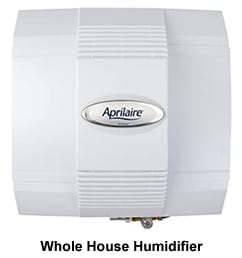 Whole-house Humidifier
Whole-house Humidifier
A whole-house humidifier is installed directly in your heating system, right inside of your ductwork next to the furnace, typically on the supply end. The humidifier will either have a humidifier pad, or a rotating wheel that continuously absorbs water from a tray. As air flows through the humidifier from the furnace, it carries tiny microscopic droplets of water up through the ductwork and sends them each room of the home.
Recommended model: Aprilaire 700 Whole House Humidifier – on Amazon for $204.64 Click here for current price.
PROS:
-
- requires very little maintenance.
- It does not cost much to operate.
- It doesn’t take up very much room.
- Great for targeting the entire house.
CONS:
-
- A little more pricey to buy upfront, then a portable humidifier would cost.
 What is a Dehumidifier
What is a Dehumidifier
A dehumidifier is the complete opposite of the humidifier. Its job is to remove access humidity (moisture) out the air. For a home setting, a portable dehumidifier is often used in basements, crawlspaces, and attics to reduce the amount of moisture and condensation during the summer months.
You don’t typically use a dehumidifier in temperatures below 60 degrees Fahrenheit because the water collected from the air could freeze on the cooling coils and damage the unit.
Benefits Of a Dehumidifiers
- Reduces Bad Odor – A dehumidifier doesn’t only remove moisture from the air; it also works by sucking up nasty, musty air, and replacing it with new fresh-smelling air. Generally when you have a musty odor in places like a basement, for example, this often means that you have mold or mildew present.
- Prevents the growth of mold and mildew – These organisms thrive in moist and damp surfaces such as walls, furniture, carpet, dirt, cardboard, etc. Mold is also very hazardous for your health.
- Helps eliminate dust mites – dust mites feed off of dead skin on both humans and pets. The fecal pellets from dust mites contain an allergen, which is highly allergic to millions of people. The Asthma and Allergy Foundation of America claims that dust mites could be the cause of year-round allergies and asthma. Dust mites can not survive in dry environments.
- Prevents rusting and corrosion – if there’s too much moisture in the air, it can accelerate the process of rusting and corrosion. It will then affect almost everything in the house, from electronics, knives to metal tools.
Different Types of Dehumidifiers
No matter which dehumidifier you choose, they all work in the same way, and that is to draw moisture from the air. Choosing the proper type of dehumidifier comes down to personal taste.
 Refrigerant Dehumidifiers
Refrigerant Dehumidifiers
A refrigerant dehumidifier or also known as a compress dehumidifier works in the same way that your refrigerator works. Inside of the dehumidifier is a metal plate that remains cool during the refrigeration process. As a fan constantly runs drawing in air from the room, that air passes over the metal plates. As the air passes over the plates, more and more moisture condenses onto the plate and drips water down into a water tank.
Once the humidity level in the room drops down to where you would like it, the dehumidifier goes into a standby mode until the humidity levels rise and trigger the unit to turn back on.
The refrigerant dehumidifier uses less energy to operate than the desiccant dehumidifier for example. One disadvantage to the refrigerant dehumidifier is that it requires the air temperature in the room to be warmer than what the air temperature in the unit is. Therefore, making it less efficient in temperatures below 50 degrees Fahrenheit.
Recommended model: Ivation Compressor Dehumidifier – on Amazon for $159.99 Click here for current price.
PROS:
-
- It uses less energy and cheaper to run than the desiccant dehumidifier.
- Works great removing humidity in rooms with a temperature above 50 degrees Fahrenheit.
CONS:
-
- Doesn’t work efficiently in temperature below 50 degrees Fahrenheit

Whole-house Ventilation Dehumidifiers
A whole-house ventilation dehumidifier works together with your home’s heating and cooling system to draw air through the ductwork. As the warm air gets pulled into the unit, it is cooled to cause the air to condense into water. The water is collected in a pan or hooked up to directly drain down a laundry sink or floor drain. The dry air is then passed over a heating element, such as a coil, to bring the air to the set room temperature.
Recommended model: Aprilaire Pro Whole House Dehumidifier – on Amazon for $1,300.00 Click here for current price.
PROS:
-
- Since it’s attached to the ductwork, it doesn’t take up extra room.
- It requires minimal maintenance.
- There is no water tank to empty.
- Very little noise.
- It uses less energy and can reduce energy costs.
- You can install one in new or older homes.
- A better solution for all-over moisture control compared to portable units.
CONS:
-
- Typically costs a little more upfront.
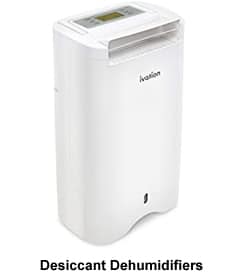 Desiccant Dehumidifiers
Desiccant Dehumidifiers
A desiccant dehumidifier has a slow-moving wheel that rotates and contains a desiccant material such as Zeolite to absorb water vapor. As the wheel rotates, a fan pulls air into the dehumidifier and dries the moisture in the air once the desiccant material comes in contact with it.
Recommended model: Ivation Desiccant Dehumidifier – on Amazon for $199.00 Click here for current price.
PROS:
-
- Desiccant material will not expire or need replacing.
- Very quiet.
- Minimal noise.
- Works great, even in low temperatures.
CONS:
-
- Limited on how much moisture they can remove each day.
- Eventually, desiccant dehumidifiers can potentially give off a pungent odor.
The Ideal Humidity Level
Finding the perfect level of humidity is very important for your health and comfort. Too much humidity, and you could end up growing mold, too little humidity, and your skin will feel itchy and dry. The American Academy of Allergy Asthma & Immunology (AAAAI), recommends that the humidity level in your home should be between 40 to 50 percent.
The easiest way to monitor the humidity levels is with a device called a hygrometer. A hygrometer can measure the amount of water vapor in the air. There are different types of hygrometers, but they all do the same, and that’s measure humidity. You can purchase a hygrometer from your local hardware store, or Amazon for as little as $11.00 Click here for current price

Humidifier vs Dehumidifier For Cough
Both a humidifier and dehumidifier can help change the moisture levels in the air, in their different ways. But which one should you use to combat and improve your symptoms depends on what your symptoms are.
How a dehumidifier can help
If your symptoms are brought on by allergies, then a dehumidifier would be the best solution for you. A dehumidifier will help pull moisture from the air, which prevents mold and mildew growth. Mold and mildew are two common triggers for allergic responses. A dehumidifier will also kill off dust mites, another very common cause for year-round allergies.
How a humidifier can help
If your respiratory symptoms are caused by the common cold, then a humidifier would be your best choice. By increasing the moisture in the air, this could help relieve sore throats, as well as nasal and chest congestion.
Breathing humid air can help loosen congestion in the chest, making it feel easier to breathe. Another hidden benefit of using a humidifier is that it will help keep you more hydrated, which is great in helping you fight off a cold.
Is a Humidifier or Dehumidifier Better For Allergies?
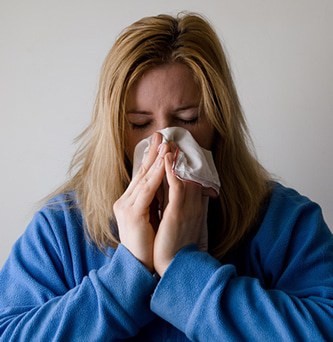 Humidifiers can play a role in both the development and treatment of allergies. Breathing in air containing a proper humidity percentage is one of the ways that you can relieve the discomfort and symptoms of allergies. For example, a humidifier will help your nasal passages clear away mucus, which allows your body to purge any allergies you get exposed to each day. Humidifiers are also useful for those who suffer from sinusitis. With the extra moisture in the air, dry air irritants won’t be as potent.
Humidifiers can play a role in both the development and treatment of allergies. Breathing in air containing a proper humidity percentage is one of the ways that you can relieve the discomfort and symptoms of allergies. For example, a humidifier will help your nasal passages clear away mucus, which allows your body to purge any allergies you get exposed to each day. Humidifiers are also useful for those who suffer from sinusitis. With the extra moisture in the air, dry air irritants won’t be as potent.
If the humidity levels are too low, you might notice that your nasal passages will become irritated, which can aggravate existing allergy symptoms.
If the humidity level is too high, like between 70 to 80 percent, common household allergens like dust mites, pollen, and mold thrive in those conditions.
Knowing where your humidity level is at is very important in determining which unit you need to use, a humidifier or a dehumidifier. That is when a hygrometer will come in handy Click here for the current price on Amazon.

Do I Need a Humidifier or Dehumidifier For Baby?
In the winter, new parents tend to turn up the heat more to keep the house warm to protect the baby from the cold. The problem with turning up the heat is that it will remove natural moisture from the air and cause the air to dry out.
You might notice that you tend to have more frequent sore throats, dry sinuses, and stuffy noses, but babies are more susceptible to infections and sicknesses during the winter months then we are.
Using a humidifier in a baby’s nursery will help in adding much-needed moisture into the air, allowing your baby to breathe more comfortably and loosen built-up mucus.
A baby’s skin is more sensitive to dry conditions and can result in skin irritation, such as red patches, chapped lips, and sore or tender areas on the body. The added moisture from the humidifier will also help relieve your baby of dry skin.
Another hidden benefit of using a humidifier in the baby’s nursery is the low hum noise that it emits while running. Not only will the humming noise drown out any other noises in the house, but it provides the baby with a calming “white noise” that can help put the baby to sleep.

Cleaning Your Humidifier
It is important that you properly clean your humidifier. A dirty humidifier can lead to serious health problems for people who already have allergies or asthma.
Water that has been sitting in the reservoir of the humidifier for a couple of days to several weeks can start to grow harmful bacteria such as mold and mildew. Without properly cleaning your humidifier, the next time that you turn it on, you will be releasing all of those allergens into the air and your lungs as you breathe.
Every day or every other day, you should be performing a basic cleaning of the humidifier. Each week you should also schedule a more in-depth cleaning routine.
Basic Cleaning (every 1 to 2 days):
Filter
-
- Unplug the humidifier and remove the filter.
- Place the filter under a faucet and thoroughly rinse it with cold water. Wash away impurities that you can see. Avoid using any cleaning solution on the filter.
- Place the filter on a clean towel to allow it to dry. Double-check with the manufacturer’s manual to see when you should replace the filter.
Water tank
-
- Remove the water tank and empty the old water.
- Add 2 to 3 cups of vinegar to the water tank and swish it all around. Let the vinegar sit on the bottom of the water tank for 1 hour. Avoid using any other cleaning products other than vinegar.
- If necessary, you can use a sponge or scrub brush and carefully remove stuck-on grime in the tank.
- Place the water tank under a faucet and thoroughly give it a good rinse.
Wipe down unit
-
- In a small bucket, add 1 to 2 cups of vinegar.
- Fill the bucket halfway with warm water.
- Dampen a sponge or soft cloth and wipe down the entire frame of the humidifier, as well as any parts.
Once a Week Cleaning:
Once a week, perform a more in-depth cleaning of the water tank using the three steps below.
Step 1:
Remove the water tank from the humidifier and empty all of the water from inside. Next, pour about 1 gallon of clean, cold water into the tank, along with a teaspoon of bleach. Let that sit for 30 to 60 minutes, any longer than that you risk damaging the machine.
Last, pour the solution out and thoroughly rinse the tank with cold, clean water from a faucet.
Important: Do not mix bleach and vinegar or peroxide and vinegar because the combination of chemicals could create a very harmful by-product.
Step 2:
With the tank thoroughly rinsed, add 2 cups of peroxide, and carefully swish it around to coat the sides and bottom of the water tank. Leave the peroxide to sit in the tank for 30 to 60 minutes, before pouring it out and once again thoroughly rinsing the tank with clean, cold water from your faucet.
Step 3:
Place the tank back onto the humidifier and add 1 to 2 cups of vinegar and at least 1 gallon of clean water. Take the humidifier outside or in your garage with the door open, and allow the unit to run for an hour. After an hour, empty the solution and rinse the tank thoroughly with clean, cold water. Fill the water tank with clean water and let the humidifier run again outside for another hour. This will help clear the lines. Once done, rinse the tank one last time with clean, cold water for your faucet before using it.
Important: Do not run bleach, peroxide, or any other chemicals through the humidifier to do a deep clean. Running anything other then vinegar and water could damage the machine.
How To Clean Your Dehumidifier
Dehumidifiers pull the moisture from the air, and while it’s doing that, it’s also pulling and collecting all sorts of bacteria, mildew, and mold, which causes them to get dirty fairly quickly. Make sure to clean your dehumidifier at least once every two weeks as an important part of its routine maintenance, especially during frequent use.
Follow these steps below to ensure your dehumidifier is clean, and keeping the air, you breathe as pure as possible.
Step 1: Turn off and unplug the dehumidifier
-
- It doesn’t matter if you are wiping the machine down, or checking the filter. Before you do anything, make sure it’s unplugged. Remember, safety first.
Step 2: Remove the filter
-
- Under your faucet, run cold water over the filter to wash away any impurities.
- Next, lather up a sponge with dish soap and carefully wipe the filter clean.
- Rinse the filter under cold water and lay it on a towel to dry.
Step 3: Empty the reservoir
-
- Remove the reservoir and empty the dirty contents.
- Add a splash of dish soap to the reservoir, and about a gallon of water.
- Swish the contents around.
- Then gently scrub the bottom and sides with a sponge to remove dirt and grim. If it is necessary, repeat scrubbing with soap and a sponge again.
- Once finished, rinse the reservoir clean.
- Lay the reservoir on a towel to dry before putting it back in.
Step 4: Clean the bucket filter
-
- The bucket filter also helps collect impurities from the air. Some dehumidifiers don’t have one, so check with the manufactures manual to confirm if yours does. If you do have one, remove it.
- Rinse the bucket filter under clean, warm water.
- Lay on a towel to dry.
Step 5: Wipe down the outside unit
-
- Dampen a clean cloth.
- Wipe down the outside of the dehumidifier, and remove any hair or dust collecting on the unit.
- DO NOT spray the dehumidifier with water or use any cleaning solvents on the unit.
That’s it. Repeat these five steps every few weeks.
How To Store a Humidifier
Before storing your humidifier in a closet or under the stairs for the season, there are a few steps that you should follow first.
- First, unplug and completely drain all of the water from the reservoir.
- Next, completely wipe down the unit and make sure that it is dry.
- Throw away any filters, cassettes, and cartridges even if they have not ben used for long.
- If possible, store the humidifier in its original box. If not, try to find a cool, dry location.
- Store the power cord on top of the unit, in the original box if you can, or in a dry location.
- Try to avoid placing objects on top of the humidifier.
Things to Be Cautious About
- Humidifiers can let off steam, which can burn your skin. Keep humidifiers out of the reach of children, and never place a warm-mist steamer in a child’s room.
- Make sure that your humidifier is not located too close to anything. Check nearby objects to ensure that they are not getting dampen by the mist that the humidifier releases into the air.
- Keep your humidifier clean. Dirty humidifiers can cause dangerous bacterial growth that can be harmful to your health. Follow proper cleaning procedures and always read the manufacturer’s instructions on proper care and maintenance.
- If your humidifier expels too much moisture into the air, this could add condensation on walls and furniture. As a result, harmful mold and mildew can grow and spread throughout your home.
- Make sure that your humidifier or dehumidifier is capable of handling the size of the room that you intend for it to cover. Each unit will specify from the manufacturer how many square feet they can cover.
